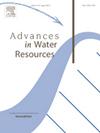Reactive transport modeling to reveal the impacts of beach morphodynamics, storm floods and seasonal groundwater recharge on the biogeochemistry of sandy subterranean estuaries
IF 4
2区 环境科学与生态学
Q1 WATER RESOURCES
引用次数: 0
Abstract
Subterranean Estuaries (STEs) are important biogeochemical reactors at the land-ocean interface. They transform dissolved species prior to discharge, thereby influencing chemical fluxes from land to sea. The coupling between physical flow and biogeochemical reactions in the STE is complex, and a deeper process understanding demands the application of reactive transport modeling (RTM). Most previous RTM studies focused on idealized STEs, investigating the impacts of relevant oceanic forcings, such as tides and waves. The aim of this study is to investigate the presently unknown interplay between STE biogeochemistry and beach morphodynamics, storm floods as well as seasonal groundwater recharge. 2-D cross-sectional RTMs for a sandy beach aquifer were developed for this purpose, assessing the effects of the three individual as well as all combined dynamic coastal forcings, respectively. We find that beach morphodynamics enhance the transience of aerobic-to-suboxic zones in near-surface groundwater, whereas storm floods cause temporal concentration changes at greater depth. The impact of seasonal groundwater recharge is less pronounced. The concentrations of dissolved species are further impacted by precipitation/dissolution of the minerals calcite, goethite, siderite, iron sulfide and hydroxyapatite as well as complexation at goethite surfaces. Our study contributes to an advanced understanding of the interplay between STE biogeochemistry and the dynamics of relevant coastal forcings encountered at high-energy beaches. However, further field-based investigations are needed to verify conclusions of our generic RTM study.
反应输运模型揭示海滩形态动力学、暴雨洪水和季节性地下水补给对沙质地下河口生物地球化学的影响
地下河口(STEs)是陆海界面上重要的生物地球化学反应器。它们在排放之前转化溶解的物种,从而影响从陆地到海洋的化学通量。STE中物理流动与生物地球化学反应之间的耦合是复杂的,更深入的过程理解需要应用反应输运模型(RTM)。以前的大多数RTM研究都集中在理想化的海温上,研究潮汐和波浪等相关海洋强迫的影响。本研究的目的是探讨STE生物地球化学与海滩形态动力学、暴雨洪水以及季节性地下水补给之间目前未知的相互作用。为此,开发了沙滩含水层的二维横截面RTMs,分别评估了三个单独的以及所有组合的动态海岸强迫的影响。我们发现,海滩形态动力学增强了近地表地下水中好氧-缺氧带的短暂性,而暴雨洪水则引起更深层次的时间浓度变化。季节性地下水补给的影响则不那么明显。溶解物质的浓度进一步受到方解石、针铁矿、菱铁矿、硫化铁和羟基磷灰石的沉淀/溶解以及针铁矿表面的络合作用的影响。我们的研究有助于深入了解STE生物地球化学与高能海滩相关海岸强迫动力学之间的相互作用。然而,需要进一步的实地调查来验证我们的通用RTM研究的结论。
本文章由计算机程序翻译,如有差异,请以英文原文为准。
求助全文
约1分钟内获得全文
求助全文
来源期刊

Advances in Water Resources
环境科学-水资源
CiteScore
9.40
自引率
6.40%
发文量
171
审稿时长
36 days
期刊介绍:
Advances in Water Resources provides a forum for the presentation of fundamental scientific advances in the understanding of water resources systems. The scope of Advances in Water Resources includes any combination of theoretical, computational, and experimental approaches used to advance fundamental understanding of surface or subsurface water resources systems or the interaction of these systems with the atmosphere, geosphere, biosphere, and human societies. Manuscripts involving case studies that do not attempt to reach broader conclusions, research on engineering design, applied hydraulics, or water quality and treatment, as well as applications of existing knowledge that do not advance fundamental understanding of hydrological processes, are not appropriate for Advances in Water Resources.
Examples of appropriate topical areas that will be considered include the following:
• Surface and subsurface hydrology
• Hydrometeorology
• Environmental fluid dynamics
• Ecohydrology and ecohydrodynamics
• Multiphase transport phenomena in porous media
• Fluid flow and species transport and reaction processes
 求助内容:
求助内容: 应助结果提醒方式:
应助结果提醒方式:


